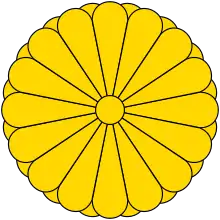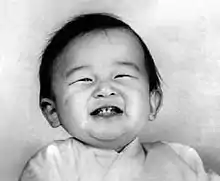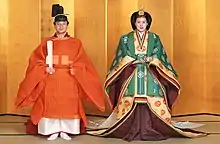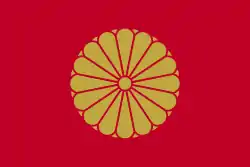Naruhito
Naruhito (徳仁, pronounced [naɾɯꜜçi̥to]; born 23 February 1960) is Emperor of Japan. He acceded to the Chrysanthemum Throne on 1 May 2019, beginning the Reiwa era, following the abdication of his father, Akihito.[1] He is the 126th monarch according to Japan's traditional order of succession.
| Naruhito | |||||
|---|---|---|---|---|---|
.jpg.webp) The Emperor in 2019 | |||||
| Emperor of Japan | |||||
| Reign | 1 May 2019 – present | ||||
| Enthronement | 22 October 2019 | ||||
| Predecessor | Akihito | ||||
| Heir presumptive | Fumihito | ||||
| Prime ministers | Shinzō Abe Yoshihide Suga | ||||
| Born | Hiro-nomiya Naruhito Shinnō (浩宮徳仁親王) 23 February 1960 Imperial Household Agency Hospital, Tokyo Imperial Palace, Tokyo, Japan | ||||
| Spouse | |||||
| Issue | Aiko, Princess Toshi | ||||
| |||||
| House | Imperial House of Japan | ||||
| Father | Akihito | ||||
| Mother | Michiko Shōda | ||||
| Religion | Shinto | ||||
 |
|
The Prince Hitachi The Princess Hitachi |
Name
Before becoming emperor, he was generally referred in the Japanese press by his given name and princely title. Upon succeeding to the throne, he is no longer referred to by his given name, but rather is referred to as "His Majesty the Emperor" (天皇陛下, Tennō Heika) which may be shortened to "His Majesty" (陛下, Heika).[2] In writing, the Emperor is also referred to formally as "The Reigning Emperor" (今上天皇, Kinjō Tennō). The era of Naruhito's reign bears the name "Reiwa" (令和) pronounced [ɾeːɰa] (![]() listen), and according to custom he will be renamed Emperor Reiwa (令和天皇, Reiwa Tennō, see "posthumous name") by order of the Cabinet after his death. The name of the next era under his successor will be established after his death or before his abdication.[3]
listen), and according to custom he will be renamed Emperor Reiwa (令和天皇, Reiwa Tennō, see "posthumous name") by order of the Cabinet after his death. The name of the next era under his successor will be established after his death or before his abdication.[3]
Early life

Naruhito was born on 23 February 1960 at 4:15 p.m. in the Imperial Household Agency Hospital in Tokyo Imperial Palace.[4] As a prince, he later quipped, "I was born in a barn inside the moat".[5] His parents, Akihito and Michiko, were then crown prince and crown princess of Japan, while his paternal grandfather, Hirohito, reigned as emperor. Reuters reported that Naruhito's paternal grandmother, Empress Kōjun, had driven her daughter-in-law and grandchildren to depression in the 1960s by persistently accusing Michiko of not being suitable for her son.[6]
Naruhito's childhood was reported to be happy, and he enjoyed activities such as mountain climbing, riding, and learning the violin. He played with the children of the royal chamberlain, and he was a fan of the Yomiuri Giants in the Central League, his favorite player being No. 3, later team manager, Shigeo Nagashima. One day, Naruhito found the remains of an ancient roadway in the palace grounds, sparking a lifelong fascination with the history of transportation, which would provide the subject of his bachelor's and master's degrees in history.[7] He later said, "I have had a keen interest in roads since childhood. On roads you can go to the unknown world. Since I have been leading a life where I have few chances to go out freely, roads are a precious bridge to the unknown world, so to speak."[8]
In August 1974, when the prince was 14, he was sent to Melbourne, Australia, for a homestay. Naruhito's father, then the Crown Prince Akihito, had had a positive experience there on a trip the year before, and encouraged his son to go as well.[9] He stayed with the family of businessman Colin Harper.[10] He got along with his host brothers, riding around Point Lonsdale, playing the violin and tennis, and climbing Uluru together.[11] Once he even played the violin for dignitaries at a state dinner at Government House hosted by Governor-General Sir John Kerr.[12]
Education
When Naruhito was four years old he was enrolled in the prestigious Gakushūin school system, where many of Japan's elite families and narikin (nouveaux riches) send their children.[13] In senior high, Naruhito joined the geography club.[14]
Naruhito graduated from Gakushuin University in March 1982 with a Bachelor of Letters degree in history.[15] In July 1983, Naruhito undertook a three-month intensive English course before entering Merton College, Oxford University, in the United Kingdom,[16] where he studied until 1986. Naruhito did not, however, submit his thesis A Study of Navigation and Traffic on the Upper Thames in the 18th Century until 1989.[17] He later revisited these years in his book, The Thames and I – a Memoir of Two Years at Oxford. He visited some 21 historic pubs, including the Trout Inn.[18] Naruhito joined the Japan Society and the drama society, and became the honorary president of the karate and judo clubs.[19] He played inter-college tennis, seeded number three out of six on the Merton team,[19] and took golf lessons from a pro.[19] In his three years at Merton he also climbed the highest peaks in three of the constituent countries of the United Kingdom: Scotland's Ben Nevis, Wales' Snowdon and Scafell Pike in England.[20]
While at Oxford, Naruhito also was able to go sightseeing across Europe and meet much of its royalty, including the British royal family.[20] The relatively relaxed manners of the United Kingdom's royals amazed him: "Queen Elizabeth II, he noted with surprise, poured her own tea and served the sandwiches."[21] He also went skiing with Liechtenstein's Prince Hans-Adam II, holidayed in Mallorca in the Mediterranean with Spain's King Juan Carlos I, and sailed with Norway's Crown Prince Harald and Crown Princess Sonja and Queen Beatrix of the Netherlands.[22]
Upon his return to Japan, Naruhito enrolled once more in Gakushūin University to earn a Master of Humanities degree in history, successfully earning his degree in 1988.[23]
Personal life
_(cropped).jpg.webp)

Marriage and family
Naruhito first met Masako Owada (staff working at the Ministry of Foreign Affairs) at a tea for Infanta Elena of Spain in November 1986,[24][19] during her studies at the University of Tokyo. The prince was immediately captivated by her,[25] and arranged for them to meet several times over the next few weeks.[26] Because of this, they were pursued relentlessly by the press throughout 1987.[27]
Despite the Imperial Household Agency's disapproval of Masako Owada, and her attending Balliol College, Oxford, for the next two years, Naruhito remained interested in Masako who worked at the Ministry of Foreign Affairs. He proposed to her three times before the Imperial Palace announced their engagement on 19 January 1993. The wedding took place on 9 June the same year at the Imperial Shinto Hall in Tokyo before 800 invited guests, including many of Europe's heads of state and royalty.[28]
By the time of their marriage, Naruhito's father had ascended the throne, so Naruhito had been invested as the crown prince with the title Prince Hiro (浩宮, Hiro-no-miya) on 23 February 1991.[29]
Masako's first pregnancy was announced in December 1999, but she miscarried.[30] Emperor Naruhito and Empress Masako have one daughter, Aiko, Princess Toshi (敬宮愛子内親王, Toshi-no-miya Aiko Naishinnō), born 1 December 2001 at the Imperial Household Agency Hospital in Tokyo Imperial Palace.[31][32]
Hobbies and interests
Naruhito is interested in water policy and water conservation. In March 2003, in his capacity as honorary president of the Third World Water Forum, he delivered a speech at the forum's opening ceremony titled "Waterways Connecting Kyoto and Local Regions". Visiting Mexico in March 2006, he gave the keynote address at the opening ceremony for the Fourth World Water Forum, "Edo and Water Transport". And in December 2007, he gave a commemorative talk at the opening ceremony for the First Asia-Pacific Water Summit, "Humans and Water: From Japan to the Asia-Pacific Region".[29]
Naruhito plays the viola, having switched from the violin because he thought the latter "too much of a leader, too prominent" to suit his musical and personal tastes.[33] He enjoys jogging, hiking, and mountaineering in his spare time.[12]
Crown Prince of Japan
The Crown Prince was a patron of the Japanese Olympic Games Committee. The prince is also a supporter of the World Organization of the Scout Movement and in 2006 attended the 14th Nippon Jamboree, the Japanese national jamboree organized by the Scout Association of Japan. The crown prince has also been an honorary vice-president of the Japanese Red Cross Society since 1994.[29]
For two weeks in 2012, Naruhito temporarily took charge of his father's duties while the Emperor underwent and recovered from heart bypass surgery.[34]
Naruhito's birthday was named "Mount Fuji Day" by Shizuoka and Yamanashi Prefectures because of his reported love of the mountain.[35]
Emperor of Japan
.jpg.webp)
On 1 December 2017, the government announced that Naruhito's father, Emperor Akihito, would abdicate on 30 April 2019, and that Naruhito would become the 126th emperor of Japan as of 1 May 2019.[36][37]
Following an abdication ceremony on the afternoon of 30 April, Akihito's reign and the Heisei era continued until the end of the day. Naruhito then succeeded him as emperor at the beginning of the day on 1 May, ushering in the Reiwa era. The transition took place at midnight. Naruhito's place as emperor was formalized in a ceremony on the morning of 1 May. In his first statement as emperor, he pledged to reflect deeply on the course followed by his father, and fulfill his constitutional responsibility "as the symbol of the state and of the unity of the people of Japan".[1]
Naruhito's enthronement ceremony took place on 22 October 2019,[38] where he was duly enthroned in an ancient-style proclamation ceremony.[39]
Selected works
- 2006 – A The Thames and I: A Memoir of Two Years at Oxford with Hugh Cortazzi. Folkestone, Kent: Global Oriental. ISBN 978-1-905246-06-9; OCLC 65196090
- 1993 – Temuzu to tomoni: Eikoku no ninenkan (テムズとともに: 英国の二年間, OCLC 032395987)
Honours
| Styles of Naruhito | |
|---|---|
 | |
| Reference style | His Majesty |
| Spoken style | Your Majesty |
National
 - Collar of the Supreme Order of the Chrysanthemum (1 May 2019)[40]
- Collar of the Supreme Order of the Chrysanthemum (1 May 2019)[40] - Grand Cordon of the Supreme Order of the Chrysanthemum (23 February 1980)[40]
- Grand Cordon of the Supreme Order of the Chrysanthemum (23 February 1980)[40] - Grand Cordon of the Order of the Paulownia Flowers (1 May 2019)[40]
- Grand Cordon of the Order of the Paulownia Flowers (1 May 2019)[40] - The Order of Culture (1 May 2019)[40]
- The Order of Culture (1 May 2019)[40].svg.png.webp) - The Golden Medal of Merit of the Japanese Red Cross[41]
- The Golden Medal of Merit of the Japanese Red Cross[41].svg.png.webp) - The Golden Medal of Honorary Member of the Japanese Red Cross[41]
- The Golden Medal of Honorary Member of the Japanese Red Cross[41]
Foreign
 Austria: Grand Decoration of Honour in Gold with Sash for Services to the Republic of Austria (1999) [42]
Austria: Grand Decoration of Honour in Gold with Sash for Services to the Republic of Austria (1999) [42].svg.png.webp) Belgium: Grand Cordon of the Order of Leopold [43]
Belgium: Grand Cordon of the Order of Leopold [43] Denmark: Knight of the Order of the Elephant (2004)[44][45]
Denmark: Knight of the Order of the Elephant (2004)[44][45] Hungary: Grand Cross of the Order of Merit of the Republic of Hungary (2000) [46]
Hungary: Grand Cross of the Order of Merit of the Republic of Hungary (2000) [46] Malaysia: Honorary Grand Commander of the Order of the Defender of the Realm (2012)[47]
Malaysia: Honorary Grand Commander of the Order of the Defender of the Realm (2012)[47] Netherlands: Recipient of the King Willem-Alexander Inauguration Medal (2013)
Netherlands: Recipient of the King Willem-Alexander Inauguration Medal (2013) Philippines: Grand Collar of the Order of Sikatuna, Rank of Raja (3 December 2002)[48]
Philippines: Grand Collar of the Order of Sikatuna, Rank of Raja (3 December 2002)[48] Portugal: Grand Cross of the Order of Christ (02/12/1993)[49]
Portugal: Grand Cross of the Order of Christ (02/12/1993)[49] Spain: Knight Grand Cross of the Order of Charles III (08/11/2008)[50]
Spain: Knight Grand Cross of the Order of Charles III (08/11/2008)[50] Sweden: Knight of the Royal Order of the Seraphim (26/03/2007)[51]
Sweden: Knight of the Royal Order of the Seraphim (26/03/2007)[51] Tonga:
Tonga:
- Knight Grand Cross with Collar of the Order of the Crown of Tonga (01/08/2008)[52]
- Coronation Medal of H.M. King George Tupou V (01/08/2008)[53]
 United Arab Emirates: Member First Class of the Order of Zayed (23/01/1995)[54][55]
United Arab Emirates: Member First Class of the Order of Zayed (23/01/1995)[54][55]
Honorary degrees
- University of Oxford, Doctor of Law[56]
Patrilineal ancestry
| Patrilineal descent[58] |
|---|
|
Notes
- "Japan's new Emperor Naruhito pledges unity". BBC News. 1 May 2019. Retrieved 2 May 2019.
- "Members of the Order of the Garter". The British Monarchy.
- "National Day of Japan to be celebrated". Embassy of Japan in Pakistan. 7 December 2007. Archived from the original on 2 February 2008. Retrieved 28 December 2007.
- "浩宮徳仁親王(現皇太子)誕生". Mainichi Shimbun. 23 February 1960. Archived from the original on 24 December 2018. Retrieved 30 April 2019.
- Hills 2006, p. 69
- "Japan's Dowager Empress Dead At 97". CBS News. 16 June 2000. Retrieved 21 October 2016.
- Hills 2006, p. 76
- Hills 2006, p. 77
- Hills 2006, p. 56
- Hills 2006, p. 57
- Hills 2006, pp. 60–61
- Hills 2006, p. 60
- Hills 2006, pp. 77–78
- Hills 2006, p. 79
- Hills 2006, p. 81
- Hills 2006, pp. 142–143, 152
- Hills 2006, pp. 144–145
- Hills 2006, pp. 145–146
- Hills 2006, p. 150
- Hills 2006, p. 151
- Hills 2006, p. 148
- Hills 2006, pp. 151–152
- "Personal Histories of Their Majesties the Emperor and Empress". The Imperial Household Agency. Retrieved 23 October 2019.
- Fitzpatrick, Beth Cooney (21 January 2011). "Great Royal Weddings: Princess Masako and Crown Prince Naruhito". Stylelist. AOL. Archived from the original on 10 September 2011. Retrieved 2 December 2016.
- Hills 2006, pp. 120–121
- Hills 2006, p. 123
- Hills 2006, p. 136
- Hills 2006, p. 2
- "Personal Histories of Their Imperial Highnesses the Crown Prince and Crown Princess". Archived from the original on 5 December 2002. Retrieved 2 December 2016.
- "Royal life takes its toll on Japan's crown princess". China Daily. 2 August 2004. Archived from the original on 6 June 2011. Retrieved 16 November 2011.
- "Girl Born to Japan's Princess". The New York Times. 1 December 2001. Retrieved 16 November 2011.
- French, Howard W. (8 December 2001). "Japan: A Name For The Royal Baby". The New York Times. Retrieved 16 November 2011.
- Hills 2006, p. 72
- "Japanese Emperor Akihito's heart surgery 'a success'". BBC News. 18 February 2012.
- 「梅原猛・川勝平太『日本思想の古層』藤原書店、2017, p. 14」
- "Emperor Akihito to abdicate on April 30, 2019". japantoday.com. Archived from the original on 3 December 2017.
- Osaki, Tomohiro (1 December 2017). "Japan sets date for Emperor Akihito's abdication as April 30, 2019". The Japan Times. Retrieved 6 January 2018.
- "Enthronement ceremony for new emperor mulled for Oct. 2019". Mainichi Shimbun. 31 December 2017. Retrieved 31 December 2017.
The government is mulling scheduling the enthronement ceremony for the next emperor for October 2019, months after Crown Prince Naruhito accedes to the Imperial Throne on May 1 that year upon his father Emperor Akihito's abdication, it has been learned.
- Japan emperor proclaims enthromement in ancient-style ceremony
- "令和元年5月1日(水)午前 | 令和元年 | 官房長官記者会見". 首相官邸ホームページ (in Japanese). 内閣官房. Archived from the original on 7 June 2019. Retrieved 7 June 2019.
- "Promotion of Blood Donation". 7 July 2016.
- "Reply to a parliamentary question about the Decoration of Honour" (PDF) (in German). p. 1299.
- Guillaume and Stephanie of Luxembourg’s religious wedding Ceremony, Prince Naruhito, having no Luxembourgish decoration, has worn the ribbon bar Archived 25 May 2013 at the Wayback Machine of Grand Cordon of the Order of Leopold
- "Modtagere af danske dekorationer". kongehuset.dk (in Danish). Retrieved 5 May 2019.
- www.borger.dk Archived 17 December 2012 at Archive.today, Persondetaljer - Hans Kejserlige Højhed Naruhito
- "Hungarian Journal, State Gazette issue 64, 2000. june 23" (in Hungarian). p. 3830.
- "Semakan Penerima Darjah Kebesaran, Bintang dan Pingat Persekutuan".
- "Filipino recipients of Japanese decorations and Japanese recipients of Philippine decorations". Official Gazette of the Republic of the Philippines.
- "Cidadãos Estrangeiros Agraciados com Ordens Portuguesas" (in Portuguese). presidencia.pt. Retrieved 13 June 2012.
- "Boletín Oficial del Estado" (PDF).
- "Wedding Of Swedish Crown Princess Victoria & Daniel Westling - Arrivals". Getty Images. 19 June 2010. Retrieved 2 December 2016.
- "Glittering Royal Events Message Board: Coronation in Tonga". 15 June 2015. Archived from the original on 5 July 2015. Retrieved 2 December 2016.
- Ito, Kazuya (4 July 2015). "Crown Princess Masako completes first duties abroad in more than 2 years". The Asahi Shimbun. Archived from the original on 5 July 2015. Retrieved 2 December 2016.
- "United Arab Emirates (Image)".
- "Japanese crown prince visits UAE".
- "Their Majesties the Emperor and Empress - The Imperial Household Agency". www.kunaicho.go.jp. Retrieved 1 May 2019.
- http://reinanzaka-sc.o.oo7.jp/kiroku/documents/20140523-3-kiji-list.pdf
- "Genealogy of the Emperors of Japan" (PDF). Imperial Household Agency. Retrieved 12 December 2020.
Sources
- Hills, Ben (2006). Princess Masako: Prisoner of the Chrysanthemum Throne. Penguin. ISBN 1585425680.
External links
| Wikimedia Commons has media related to Emperor Naruhito. |
- Their Majesties the Emperor and Empress at the Imperial Household Agency website
- Press Conference by His Imperial Highness The Crown Prince on the Occasion of His Birthday (2017)
Naruhito Born: 23 February 1960 | ||
| Regnal titles | ||
|---|---|---|
| Preceded by Akihito |
Emperor of Japan 2019–present |
Incumbent Heir presumptive: Fumihito |

